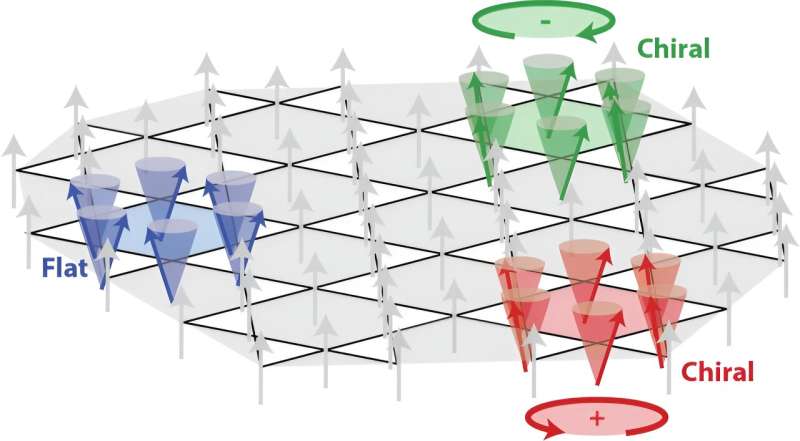This article has been reviewed according to Science X's editorial process and policies. Editors have highlighted the following attributes while ensuring the content's credibility:
fact-checked
peer-reviewed publication
trusted source
proofread
Researchers find unexpected excitations in a kagome layered material

Researchers from the U.S. Department of Energy Ames National Laboratory have discovered an unexpected chiral excitation in the kagome layered topological magnet TbMn6Sn6. This chiral excitation can be viewed as a localized magnetic swirl or vortex. The team also confirmed the existence of localized flat band magnons, a novel excitation associated with frustrated kagome lattice geometry.
For the past few of years a team of Ames Lab scientists, led by Rob McQueeney, has been investigating TbMn6Sn6 to learn more about the material, its properties, and how it behaves at different temperatures and magnetic fields. According to McQueeney, the material was known for quite a while, but it came back up on researchers' radars about five years ago. "This material has been a goldmine for interesting phenomena," said McQueeney.
In their investigation of this material so far, the team has mapped out its magnetic excitations at low energies and studied how these excitations evolve through a temperature-dependent magnetic spin reorientation transition. Their latest findings come from studying the material's high energy excitations.
The study is titled "Chiral and flat-band magnetic quasiparticles in ferromagnetic and metallic kagome layers," and it is published in the journal Nature Communications.
McQueeney explained that based on theoretical models, they expected to find localized flat-band magnons due the special geometry of the kagome lattice. Magnons are quasiparticles, or elementary excitations, that control a material's magnetization.
"Flat-band excitations are localized, so the magnetic excitation doesn't propagate like a wave, it just sits localized to a single hexagon. And an excitation in another hexagon in the lattice doesn't talk to the other one, they just kind of sit there and they fluctuate around in these hexagons," said McQueeney. "In a kagome layer, those flat bands are guaranteed by the lattice geometry."
Aside from observing these localized, flat-band magnons, the team was surprised to discover a different type of localized excitation.
"We saw another excitation, which shouldn't be there," McQueeney said. "When we looked at the momentum distribution, this had the character of what they call a chiral excitation. Chirality means it has a handedness, so there's left- and right-handed versions of the excitation. And we found that it was also localized to a hexagon, just like the flat band."
He further explained that TbMn6Sn6 has ferromagnetic kagome layers, but the chiral excitations suggest that a competing chiral antiferromagnetic instability is close by. A material's magnetic state determines its functional properties. For example, ferromagnets strongly attract other magnetic materials, while antiferromagnets do not have a magnetic field outside of the material (so they do not attract other magnets).
In this material, the ferromagnetic state is more stable than the chiral antiferromagnetism that the team discovered. However, McQueeney said that since the chiral excitations are there, perhaps tweaking the chemical makeup of the material could stabilize the chiral order.
"People are always searching for chiral ground states," McQueeney said. "The reason we use the concept of quasiparticle here is because it is a way of transmitting energy or information, like an electron is a quasiparticle, and we can send it from point A to point B, carrying some information.
"A chiral quasiparticle would have other attributes to it. It would have a handedness, for example, and so you could think about novel ways to, say, transmit information from point A to point B, which didn't involve moving a charge, but moving some chiral signal."
Discovering this new chiral excitation was especially exciting for McQueeney, "You don't expect it to be there," he said. "And we still don't understand why it's there. As a matter of fact, we're setting up other experiments to look for it in other materials."
More information: S. X. M. Riberolles et al, Chiral and flat-band magnetic quasiparticles in ferromagnetic and metallic kagome layers, Nature Communications (2024). DOI: 10.1038/s41467-024-45841-8
Journal information: Nature Communications
Provided by Ames National Laboratory





















